People have complicated relationships with food. Some eat too much, others too little. Many have no idea what they are eating; others are hyperaware and strive for the best dining experience possible. None of us wants to be misled about what we are consuming, especially if we are paying a premium price, have allergies to certain food types, or have a cultural or religious reason to proscribe certain foods entirely.
Yet there are many food producers who will ignore consumers’ wishes by passing off one product as another, creating counterfeit foods, making fake labels or adding cheap bulk products to otherwise pure ingredients. Poorly produced grape juice labeled as “Champagne.” Inexpensive ground pork added to beef and sold to Jewish and Muslim communities. Sorting out the good from the bad has become an important segment of the food industry, and scientists around the globe are addressing it through refined Fourier transform infrared (FTIR) spectroscopy techniques.
As any craftsman will tell you, you must use quality materials or you’ll end up with an inferior product. A chief concern among cheesemakers is whether the milk they use as a base has been adulterated with a foreign substance – even with the milk from a different animal. To make even a common Pecorino Romano, for example, you don’t want any cow’s milk cut into the sheep’s contribution.

Shown are colonies of microorganisms isolated from the surface of a cheese. The flora is composed of different organisms and contributes to aroma development. Courtesy of Mareike Wenning.
Nonetheless, unscrupulous people will try to pass off blended milk to cheesemakers because cow’s milk is cheaper and, therefore, more profitable. Furthermore, you can’t tell most processed milk products apart by eye.
At the University of Manchester in the UK, researchers aren’t depending on their eyesight to identify adulterated milk. Nor are they using expensive or time-consuming processes such as gel electrophoresis, chromatography or polymerase chain reactions. Instead, they are using FTIR spectroscopy.
“With increased interest in nutrition, people are more and more aware of what they are putting in their mouths,” said Royston Goodacre, a professor of biological chemistry at the university. “This includes making sure when they pay money for a product that it is what it says it is on the label.”
Using a Bruker IR spectrometer outfitted with a deuterated triglycine sulfate detector, Goodacre and his colleagues tested samples of sheep’s milk adulterated with cow’s milk, goat’s milk adulterated with cow’s milk, sheep’s milk adulterated with goat’s milk, and a mixture of all three types. They also made these samples with various levels of adulterants, in steps of 5 percent. Scans of the samples were made in the 1000 to 600 cm-1 range at a resolution of 4 cm-1. The group reported its findings in the December 2010 issue of the Journal of Dairy Science.
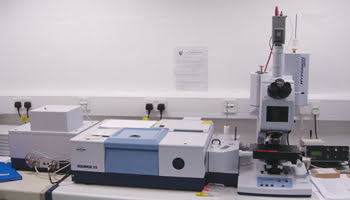
At the University of Manchester, Royston Goodacre and his colleagues are using FTIR spectroscopy to verify the purity of milk products. The key components are a Bruker motorized microplate module (left) coupled to a Bruker Equinox 55 IR spectrometer equipped with a deuterated triglycine sulfate detector. Courtesy of R. Goodacre.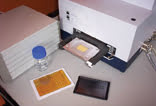
The team readily teased out minor differences between pure samples of each type; for example, there is a notable difference in sheep’s milk at the CH2 absorption band at ~2927 cm-1, an area related to the acyl chain of fatty acids. Other readily apparent differences appeared at 1654 and 1544 cm-1 (proteins) and at 1159 and 1076 cm-1 (lactose), which also showed up in higher amounts in sheep’s milk than in the others’.
The differences in pure samples, although discernible, were too subtle to help determine proportions of adulterated samples. For this, the researchers turned to scrutinizing the data with a combination of statistical tools, including linear partial least squares (PLS) and nonlinear Kernel PLS analysis. They satisfactorily identified the various levels of adulteration in mixtures of two types of milk and mixtures of all three, with typical errors in the 5 to 8 percent range, well under the amount unscrupulous suppliers would undertake to maximize their profits.
Goodacre and his colleagues are now investigating adjunct approaches to study food adulteration and their other favorite topic: bacterial contamination. These include Raman spectroscopy, surface-enhanced Raman spectroscopy and matrix-assisted laser desorption ionization mass spectrometry.
Another problem plaguing the food industry is the presence of microorganisms. Some organisms are desirable, such as Saccharomyces cerevisiae, and some are not, such as Salmonella spp. Determining which tiny creatures are spreading throughout a food product is an important step for farmers, packagers, distributors and consumers alike.
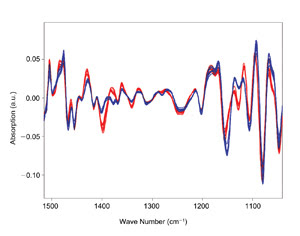
In this comparison of second derivatives of two yeast strains, Saccharomyces cerevisiae is shown in blue and Pichia anomala in red. Courtesy of Mareike Wenning.
At Technical University of Munich in Germany, Mareike Wenning and her colleagues have been working with FTIR spectroscopy for more than a decade to elucidate species – and subspecies – of microbes that cause food spoilage.
To Wenning’s group, FTIR supplies reliable identification of food-borne microbes at low cost and with high throughput. It also permits identification of subspecies, which helps in the analysis of the routes that contaminants take in the food production chain before flourishing.
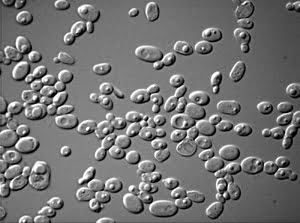
A microscopic image of Candida sp. Courtesy of Mareike Wenning.
“The development of reference databases is tightly linked to this service, as we now nearly exclusively use FTIR for identification, and the majority of our reference spectra originate from the food samples that we analyze,” she said.
In a paper published in the August 2010 Journal of Biophotonics, for example, Wenning and her colleagues reported data on lactic acid bacteria, a wide-ranging group of species including Streptococcus, Enterococcus and Lactococcus. These bacteria appear in fermented foods and beverages. Although there is a large number of subspecies in the group, there is not much separating them spectrally.
Normally, microorganisms such as lactic acid bacteria have a spectral fingerprint inside the 900- to 700-cm-1 range. Because of the complexity and homogeneity of the subspecies, however, Wenning’s group expands on that.
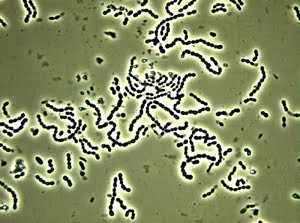
A microscopic image of Streptococcus sp., also known as lactic acid bacterium. Courtesy of Mareike Wenning.
“I would consider the whole spectrum a fingerprint,” she said. “Because the spectra of the microbial cells are so complex, that useful information needs to be extracted using techniques of pattern recognition.”
To aid with this identification of patterns as a means to distinguish subspecies, the group uses NeuroDeveloper, an artificial neural network (ANN) specifically designed to analyze FTIR spectra. The ANN complements the team’s existing large spectral libraries because it can handle the huge number of variables involved in sorting out closely related subspecies.
Set to the task of identifying both pro-biotic and environmental strains of Enterococcus faecium from 92 subspecies of lactic acid bacteria belonging to nine genera, the ANN-based technique had an accuracy of 93.2 percent at the species level and 97.1 percent at the strain level.
“We are not engaged in improving the technology itself,” Wenning said, “but we aim to compile comprehensive reference libraries and to investigate how they need to be composed to achieve good identification accuracy.”
As is the case with lactic acid bacteria, many microbial pathogens are found in a multitude of subspecies and physiological states. Finding the best way to distinguish between different types of fungal spores, for example, or two identical types that might be in different stages of activity is an ongoing effort of research teams around the world.
In Warsaw, Poland, scientists at the Military University of Technology and the Military Institute of Hygiene and Epidemiology are concerned with microbial contamination of food, medicine and other substances. In the April 2011 issue of Spectrochimica Acta Part A: Molecular and Biomolecular Spectroscopy, Miron Kaliszewski and his colleagues report on their efforts to characterize various relevant pathogens using horizontal attenuated total reflection (ATR)-based FTIR spectroscopy.
In normal ATR techniques, a sample is placed on a vertically positioned crystal, such as zinc selenide, that transmits efficiently in the IR. The crystal creates evanescent waves from light beams that are reflected within it, and these waves penetrate the sample, generating a recordable absorption/transmittance spectrum.
Although the technique provides good spectral data, contact between sample and crystal is difficult to maintain – nearly impossibly so for anything other than solid samples. Food products, for example, often are not simple solids, so Kaliszewski and his group switched to a horizontal ATR setup.
“The horizontal position of the sample surface,” he said, “enables the analysis of almost all sample materials.”
Using a Perkin-Elmer spectrometer and a horizontal ATR attachment, the researchers measured an assortment of fungi, vegetative bacteria cells and bacterial endospores. They found several key bands that aided discrimination between species, including a number of bands in the 1000- to 600-cm-1 range that were not influenced by the presence of water in the samples.
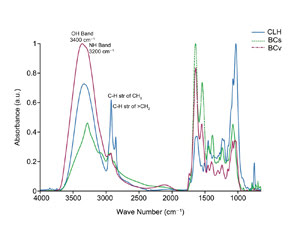
Shown are the full spectra of Cladosporium herbarum (CLH), a fungus; Bacillus cereus endospores (BCs); and B. cereus vegetative cells (BCv), acquired using FTIR spectroscopy with a horizontal attenuated total reflection attachment. Reused with permission of Spectrochimica Acta Part A: Molecular and Biomolecular Spectroscopy.
Satisfied with the speed and accuracy of the technique as well as the lack of special preparation requirements because of the horizontal ATR method, the group is continuing to add to its database of biological agents.
“Our goal is to minimalize sample volume [to] what can be achieved with one-drop FTIR technique,” Kaliszewski said.